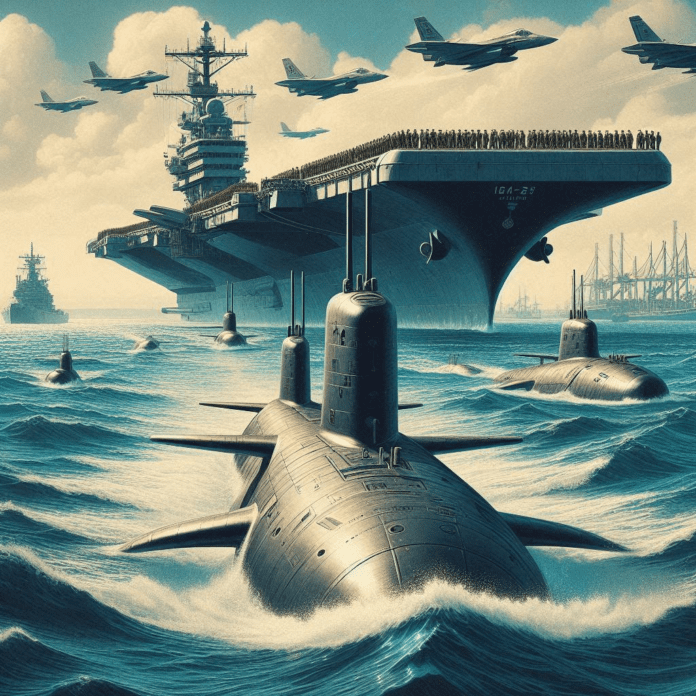In recent times, there have been significant developments in military activities involving China. Chinese warships made a notable visit to Alaska, signalling a bold projection of power. Additionally, China has commenced joint military drills with Russia, further showcasing its growing military alliances. Amidst these events, the Rim of the Pacific Exercise (RIMPAC) 2024 is underway in the Indo-Pacific, emphasizing the crucial role of submarines in future conflicts, particularly with China. Submarines, with their stealth and power, are essential for maintaining security and stability in the region.
Submarines: Stealth and Power Under the Sea
Submarines are unique military vessels because they can travel underwater undetected. This ability to move silently beneath the waves makes them extremely difficult to find and track. This stealth is a crucial advantage in any military conflict, allowing submarines to gather intelligence, avoid detection, and strike enemy targets unexpectedly.
The U.S. Navy operates the largest and most advanced submarine fleet in the world. With over 70 nuclear-powered submarines, the fleet includes both attack submarines and ballistic missile submarines. Attack submarines are designed to hunt and destroy enemy ships and submarines. They are also capable of launching special operations forces for covert missions. Ballistic missile submarines, on the other hand, carry nuclear missiles, providing a powerful deterrent against any potential adversary.
During RIMPAC 2024, the importance of submarines is emphasized by top naval officials. They highlight the need to have more submarines ready for action, whether they are new or undergoing maintenance. This focus ensures that the U.S. Navy remains prepared to respond swiftly and effectively to any threats in the Indo-Pacific region.
India Joins RIMPAC
The Indian Navy’s P-8I aircraft has joined RIMPAC 2024, the world’s largest international maritime exercise hosted by the US Pacific Fleet in Hawaii. With 29 participating countries, including India, RIMPAC aims to enhance multilateral relations and operational readiness across the Indo-Pacific. One key focus of this exercise is the importance of submarines in future conflicts, especially with China. Submarines are stealthy, powerful, and play a vital role in maintaining security and stability in the region.
Submarines as a Deterrent
Submarines play a crucial role in deterring potential adversaries, including China. The mere presence of these stealthy vessels in the region acts as a powerful warning. Potential enemies know that submarines can strike at any time from unseen locations, making it risky to engage in aggressive actions.
In response to increasing Chinese aggression in the Indo-Pacific, the U.S. and its allies are showcasing their united strength through exercises like RIMPAC. This show of force serves as a reminder that the U.S. is committed to defending the region and maintaining peace and stability. The U.S. Navy’s submarine fleet, with its advanced capabilities, is a key component of this deterrence strategy.
US-China War: Looming Threat Over Philippines Strategic Role in Spratly Islands
Partnerships and Interoperability
RIMPAC is not just about demonstrating military might; it’s also about building partnerships and improving interoperability among allied forces. Interoperability means that different countries’ militaries can work together seamlessly. This is crucial in any future conflicts, particularly with a powerful adversary like China.
Dozens of countries participate in RIMPAC, bringing their own warships, aircraft, and troops. They train together, learning to operate as a cohesive unit. This joint training ensures that allied forces can respond quickly and effectively to any threat, leveraging each other’s strengths and capabilities.
Philippines May Acquire First Attack Submarine; Amid Rising Tensions with China
Top naval officials emphasize the importance of these partnerships during the exercise. They highlight that working together on areas of mutual concern helps maintain freedom of the seas and upholds the rules-based international order. This order has supported peace, stability, and prosperity for many years, and maintaining it is a shared goal among the participating nations.
The U.S. Navy is deeply committed to maintaining a strong presence in the Indo-Pacific. Despite other global challenges, such as the ongoing conflict in Ukraine, the U.S. remains focused on the Indo-Pacific as a key area of operations. This commitment is evident in the scale and scope of RIMPAC, the largest international maritime exercise in the world.
India to Conduct Malabar Exercise with QUAD to Confront China’s Aggression
The training during RIMPAC covers a wide range of mission sets. These include carrier operations, anti-submarine warfare, surface warfare, air combat, amphibious operations, maritime security operations, and disaster relief. This comprehensive training ensures that participating forces are prepared for any scenario, making them more effective in maintaining regional security.
Squad Shield: US Prefers Philippines over India Amid Rising South China Sea Tensions
Submarines are a critical component of future conflicts, particularly with China. Their stealth, power, and versatility make them invaluable assets in maintaining security and stability in the Indo-Pacific. Exercises like RIMPAC highlight the importance of submarines and the commitment of the U.S. and its allies to defending the region. By showcasing their combat capabilities and building strong partnerships, these nations send a clear message of deterrence to any potential adversaries.


